Dimensional and Surface Quality Evaluation of Inconel 718 Alloy After Grinding with Environmentally Friendly Cooling-Lubrication Technique and Graphene Enriched Cutting Fluid
Abstract
1. Introduction
2. Materials and Methods
2.1. Material Characterization
2.2. Grinding Parameters
Cooling-Lubrication Condition (CLC)
- Flood: semi-synthetic emulsifiable oil, Vasco 7000 from Blaser Swisslube (Blaser Swisslube, Hasle-Rüegsau, Switzerland), diluted in water in a proportion of 1:9, which was monitored with the aid of a refractometer (N1, ATAGO). The coolant was delivered with a pressure near to the atmospheric one and with a flow rate of 522 L/h (522,000 mL/h).
- MQL WG: WG stands for without multilayer graphene platelets, i.e., only oil. In this condition the oil (Vasco 7000) was delivered without water and solid particles. The flow rate and compressed-air pressure for the MQL technique were 240 mL/h and 0.5 MPa, respectively, for all the tests using the MQL technique;
- MQL MG 0.05%: this condition refers to Vasco 7000 oil with multilayer graphene (MG) platelets added as 0.05% by weight, applied via the MQL technique;
- MQL MG 0.10%: this refers to Vasco 7000 oil with multilayer graphene platelets added as 0.10% by weight, also applied via the MQL technique.
2.3. Dimensional Measurements
- (1)
- Fixation of workpiece in the precision vise;
- (2)
- Preparation of the workpiece surface by grinding with the same cutting parameters detailed in Table 4, with the exception of radial depth of cut, which was equal to 10 µm, i.e., soft grinding conditions;
- (3)
- The set (vise + workpiece), gauge blocks, and the analog outside micrometer were kept on a granite table in a temperature-controlled room for 12 h to ensure the measurement temperature of 20 °C;
- (4)
- A gauge block was used to avoid errors due to the vise geometry;
- (5)
- Measurements were performed following all the statistical recommendations;
- (6)
- The set was put in the same room as the grinder machine for 12 h before the grinding trial to achieve thermal balance;
- (7)
- The grinding operation was performed;
- (8)
- The set was cleaned;
- (9)
- Step 3 was repeated to ensure the proper measurement temperature of 20 °C;
- (10)
- Measurements of the height of workpieces included ten measurements for each workpiece;
- (11)
- Repetition of tests for the different cutting parameters and colling-lubrication conditions and replica.
- Definition of the measurand or output variable;
- Identification of input variables that may affect the measurement of the output variable;
- Mathematical model of the measurand as a function of all input variables;
- Calculation of the standard uncertainty associated with each input variable (u);
- Calculation of the combined standard uncertainty regarding the output variable (uc);
- Calculation of effective degrees of freedom;
- Assessment of the expanded uncertainty regarding roughness (U);
- Mathematical expression of the measurement result.
2.4. Surface Roughness and Surface Morphology
2.5. Instant Grinding Power Measurements
2.6. Design of Experiment (DOE) and Statistical Analysis
3. Results and Discussion
3.1. Removed Height and Dimensional Tolerance After Grinding
3.2. Surface Finish and Surface Morphology
3.3. Electric Power
4. Conclusions
- Considering the lowest depth of cut (ae = 20 µm), the dimensional accuracy in terms of International Tolerance (IT) grade was in the range from IT5–IT6 for flood and MQL WG (only oil), and IT6–IT7 for MQL MG 0.05% and MQL MG 0.10%;
- The improved lubricating properties of the MQL MG 0.10% contributed to reduce the friction of material sliding through abrasive grits with no material removal, thereby reducing the removed height in comparison to the other cooling-lubrication conditions;
- Grinding with radial depth of cut (ae) of 40 µm increased the removed material in comparison to the lower ae (20 µm). In terms of the cooling-lubrication conditions tested, the MQL WG resulted in the lowest International Tolerance (IT) grade (IT6–IT7), followed by MQL MG 0.10% (IT7), MQL MG 0.05% (IT7–IT8), and flood (IT8);
- Overall, regardless of the ae, the MQL without graphene (MQL WG) was the condition in which the removed height was closest to the set depth of cut;
- With respect to the multilayer graphene (MG), its presence in the cutting fluid contributed to reducing the removed height due to an enhanced micro-plowing mechanism, thereby indicating an improvement in lubrication capacity related to plastic deformation with no material removal. Additionally, the reduction in the removed height when grinding with MG suggests lower thermal expansion of the workpiece during grinding, which may be associated with better temperature control;
- The addition of multilayer graphene (MG) significantly reduced Ra roughness, and the condition MQL MG 0.05% outperformed others when grinding with the severest cutting condition (ae = 40 µm);
- Evidence of intense plastic deformation occurred when grinding with MG and ae = 20 µm, indicating that micro-plowing was the predominant mechanism during chip formation. This characteristic was also observed when grinding at the highest depth of cut value combined with the MQL WG condition, possibly associated with insufficient cooling capacity of the MQL technique without MG;
- The electric power increased with the radial depth of cut due to the higher chip thickness, which led to more material being removed from the workpiece, which increases grinding forces and electric power as well. The highest measured values were obtained for the MQL WG condition being 1.24 kW and 1.91 kW for ae equal to 20 µm and 40 µm, respectively. The lowest values for ae = 20 µm were 0.82 kW measured for the MQL 0.10% condition and for ae = 40 µm it was 1.51 kW as a result of the MQL 0.05% condition;
- With respect to the influence of CLC on the electric power, the lower values were obtained for the conditions with MG, evidencing that the presence of MG at the contact zone in fact improved lubrication, even resulting in no material removal (micro-plowing) when grinding with ae = 20 µm, and that a reduction in friction force strongly reduces the total grinding force, and therefore reduces the grinding power;
- The use of the MQL technique with graphene enriched cutting fluids can improve Inconel 718’s grindability in terms of surface finish and electric power, although slightly increasing dimensional deviation in comparison to traditional MQL (only oil). Thus, based on the findings of this work, these cooling-lubrication conditions can replace the flood technique for a more environmentally sustainable grinding process.
Author Contributions
Funding
Institutional Review Board Statement
Informed Consent Statement
Data Availability Statement
Acknowledgments
Conflicts of Interest
References
- Darwish, S.M. Effect of tool bit insert-holder assembly on dimensional accuracy and geometrical tolerances of machined workpieces. Int. J. Mach. Tools Manuf. 1995, 35, 841–849. [Google Scholar] [CrossRef]
- Kopac, J.; Sokovic, M. Dimensional accuracy and cost optimisation in the ®nish machining of cold formed parts. n.d. J. Mater. Process Technol. 1999, 92–93, 335–343. [Google Scholar] [CrossRef]
- Alfattani, R.; Yunus, M.; Selvarajan, L.; Venkataramanan, K. Spark erosion behavior in the machining of MoSi2–SiC ceramic composites for improving dimensional accuracy. J. Mech. Behav. Biomed. Mater. 2023, 148, 106166. [Google Scholar] [CrossRef]
- Prakash, J.; Equbal, M.I.; Equbal, A. Investigative study on dimensional accuracy of machined cavity formed during EDM of AISI 1035. Mater. Today Proc. 2021, 47, 3217–3220. [Google Scholar] [CrossRef]
- Muthuramalingam, T.; Moiduddin, K.; Akash, R.; Krishnan, S.; Hammad Mian, S.; Ameen, W.; Alkhalefah, H. Influence of process parameters on dimensional accuracy of machined Titanium (Ti-6Al-4V) alloy in Laser Beam Machining Process. Opt. Laser Technol. 2020, 132, 106494. [Google Scholar] [CrossRef]
- Zhang, R.; Wang, Z.; Li, Z.; Tan, R.; Zhang, J.; Sun, T. Enhancing controllability in ultra-precision grinding of anisotropic rounded diamond tools through an in situ feature identification approach. J. Manuf. Process 2024, 132, 721–734. [Google Scholar] [CrossRef]
- Zhang, Z.; Zhang, S.; Hao, G.; Zhang, Q.; Fu, X.; Yao, P. Effect of spindle deformation on the binderless WC cylindrical microlens array molds in ultra-precision combined grinding. Int. J. Refract. Met. Hard Mater. 2024, 122, 106737. [Google Scholar] [CrossRef]
- Wang, S.; Zhang, Q.; Zhao, Q.; Zhou, M. Investigate on surface/subsurface damage mechanisms and manufacturability of ultra-smooth surface in ultra-precision ductile grinding of sapphire optics. J. Mater. Res. Technol. 2025, 34, 1966–1989. [Google Scholar] [CrossRef]
- Yin, H.; Wang, S.; Zhao, Q. Investigation on the surface topography and surface/subsurface damage mechanisms of polycrystalline yttrium aluminum garnet ceramics in ultra-precision grinding. Mater. Charact. 2025, 220, 114688. [Google Scholar] [CrossRef]
- Xu, J.; He, Q.; Zhang, X.; Yi, X.; Yu, Y.; Li, Y.; Zhang, L.; Gu, R.; Zhang, F. Investigation into the role of Si and SiC phases in RB-SiC ceramics surface modified ultra-precision grinding. Mater. Sci. Semicond. Process 2024, 184, 108786. [Google Scholar] [CrossRef]
- Li, H.; Zou, L.; Lv, C.; Wang, Z.; Wang, W.; Huang, Y. An optimization framework for enhancing profile accuracy in robotic grinding of compressor blade edge. Chin. J. Aeronaut. 2025, 38, 103228. [Google Scholar] [CrossRef]
- Li, H.; Zou, L.; Lv, C.; Gui, L.; Wang, W.; Huang, Y. Collaborative improvement of profile accuracy and aerodynamic performance in robotic grinding of transonic compressor blade leading edge. Aerosp. Sci. Technol. 2024, 146, 108937. [Google Scholar] [CrossRef]
- Aspinwall, D.K.; Soo, S.L.; Curtis, D.T.; Mantle, A.L. Profiled superabrasive grinding wheels for the machining of a nickel based superalloy. CIRP Ann. Manuf. Technol. 2007, 56, 335–338. [Google Scholar] [CrossRef]
- Klocke, F.; Soo, S.L.; Karpuschewski, B.; Webster, J.A.; Novovic, D.; Elfizy, A.; Axinte, D.A.; Tönissen, S. Abrasive machining of advanced aerospace alloys and composites. CIRP Ann. Manuf. Technol. 2015, 64, 581–604. [Google Scholar] [CrossRef]
- Chen, S.; Bai, T.; Zhang, Y.; Fang, Z.; Chen, Z. Geometric error suppression of six-axis machine tool for blisk full-shape surface grinding via constrained error sensitivity analysis. Precis. Eng. 2024, 88, 1–14. [Google Scholar] [CrossRef]
- Ezugwu, E.O.; Bonney, J.; Yamane, Y. An overview of the machinability of aeroengine alloys. n.d. J. Mater. Process Technol. 2003, 134, 233–253. [Google Scholar] [CrossRef]
- Ezugwu, E.O. Key improvements in the machining of difficult-to-cut aerospace superalloys. Int. J. Mach. Tools Manuf. 2005, 45, 1353–1367. [Google Scholar] [CrossRef]
- De Oliveira, D.; De Paiva, R.L.; da Silva, R.B.; de Carvalho Castro, P.H. Assessment of the grindability of Inconel 718 under different coolant delivery techniques. J. Braz. Soc. Mech. Sci. Eng. 2020, 42, 20. [Google Scholar] [CrossRef]
- Yin, G.; Marinescu, I.D.; Weismiller, M.C. Grinding force performance with different types of grinding fluids based on a semi-empirical force model. Int. J. Abras. Technol. 2016, 7, 167–186. [Google Scholar] [CrossRef]
- de Oliveira, D.; da Silva, R.B.; Arencibia, R.V. Evaluation of dimensional deviation in nickel-base, Inconel 718, alloy after grinding under different cooling-lubrication techniques. Rev. Mater. 2019, 24. [Google Scholar] [CrossRef]
- Malkin, S.; Guo, C. Grinding Technology—Theory and Applications of Machining with Abrasives, 2nd ed.; Industrial Press: New York, NY, USA, 2008. [Google Scholar]
- Esmaeili, H.; Adibi, H.; Rizvi, R.; Rezaei, S.M. Coupled thermo-mechanical analysis and optimization of the grinding process for Inconel 718 superalloy using single grit approach. Tribol. Int. 2022, 171, 107530. [Google Scholar] [CrossRef]
- Virdi, R.L.; Chatha, S.S.; Singh, H. Machining performance of Inconel-718 alloy under the influence of nanoparticles based minimum quantity lubrication grinding. J. Manuf. Process 2020, 59, 355–365. [Google Scholar] [CrossRef]
- ISO-286; ISO Code System for Tolerances on Linear Sizes. International Organisation for Standardisation (ISO): Geneva, Switzerland, 2010.
- Klocke, F.; Klink, A.; Veselovac, D.; Aspinwall, D.K.; Soo, S.L.; Schmidt, M.; Schilp, J.; Levy, G.; Kruth, J.-P. Turbomachinery component manufacture by application of electrochemical, electro-physical and photonic processes. CIRP Ann. Manuf. Technol. 2014, 63, 703–726. [Google Scholar] [CrossRef]
- de Oliveira, D.; Gomes, M.C.; da Silva, M.B. Spheroidal chip in micromilling. Wear 2019, 426–427, 1672–1682. [Google Scholar] [CrossRef]
- de Paiva, R.L.; de Oliveira, D.; da Silva, R.B. The Influence of Base Fluid and Graphene Nanoparticles Concentration on Surface Integrity of SAE 52100 Steel After Grinding. In ABCM Series on Mechanical Sciences and Engineering; Springer: Cham, Switzerland, 2024; pp. 201–209. [Google Scholar] [CrossRef]
- De Oliveira, D.; Da Silva, R.B.; Gelamo, R.V. Influence of multilayer graphene platelet concentration dispersed in semi-synthetic oil on the grinding performance of Inconel 718 alloy under various machining conditions. Wear 2019, 426–427, 1371–1383. [Google Scholar] [CrossRef]
- Marinescu, I.D.; Hitchiner, M.P.; Uhlmann, E.; Rowe, W.B.; Inasaki, I. Handbook of Machining with Grinding Wheels, 2nd ed.; CRC Press/Taylor & Francis: Boca Raton, FL, USA, 2016. [Google Scholar]
- Alberts, M.; Kalaitzidou, K.; Melkote, S. An investigation of graphite nanoplatelets as lubricant in grinding. Int. J. Mach. Tools Manuf. 2009, 49, 966–970. [Google Scholar] [CrossRef]
- de Oliveira, D.; de Paiva, R.L.; de Souza Ruzzi, R.; Jackson, M.J.; Gelamo, R.V.; Machado, A.R.; da Silva, R.B. A comprehensive evaluation of the use of graphene enriched cutting fluids on the surface integrity of very poor-grindability materials. Wear 2025, 571, 205811. [Google Scholar] [CrossRef]
- de Souza Augusto, G.; Scarmínio, J.; Catarini Silva, P.R.; de Siervo, A.; Rout, C.S.; Rouxinol, F.; Gelamo, R.V. Flexible metal-free supercapacitors based on multilayer graphene electrodes. Electrochim. Acta 2018, 285, 241–253. [Google Scholar] [CrossRef]
- Guo, W.; Li, G.; Zheng, Y.; Dong, C. Measurement of the thermal conductivity of SiO2 nanofluids with an optimized transient hot wire method. Thermochim. Acta 2018, 661, 84–97. [Google Scholar] [CrossRef]
- Tso, P.-L.L. Study on the grinding of Inconel 718. J. Mater. Process. Tech. 1995, 55, 421–426. [Google Scholar] [CrossRef]
- Marinescu, I.D.; Rowe, W.B.; Dimitrov, B.; Inasaki, I. Tribology of Abrasive Machining Processes, 1st ed.; William Andrew, Inc.: Norwich, NY, USA, 2004. [Google Scholar]
- GUMJCGM. Guide to the Expression of Uncertainty in Measurement—Part 1: Introduction; Bureau International des Poids et Mesures: Sèvres, France, 2023. [Google Scholar] [CrossRef]
- ABNT NBR ISO 4287:2002; Geometrical Product Specifications (GPS)—Surface Texture: Profile Method—Terms, Definitions and Surface Texture Parameters. Associação Brasileira de Normas Técnicas: Rio de Janeiro, Brazil, 2002.
- Sharma, A.K.; Tiwari, A.K.; Dixit, A.R. Effects of Minimum Quantity Lubrication (MQL) in machining processes using conventional and nanofluid based cutting fluids: A comprehensive review. J. Clean. Prod. 2016, 127, 1–18. [Google Scholar] [CrossRef]
- Hadad, M.J.; Tawakoli, T.; Sadeghi, M.H.; Sadeghi, B. Temperature and energy partition in minimum quantity lubrication-MQL grinding process. Int. J. Mach. Tools Manuf. 2012, 54–55, 10–17. [Google Scholar] [CrossRef]
- Lee, P.H.; Nam, J.S.; Li, C.; Lee, S.W. An experimental study on micro-grinding process with nanofluid minimum quantity lubrication (MQL). Int. J. Precis. Eng. Manuf. 2012, 13, 331–338. [Google Scholar] [CrossRef]
- Wang, Y.; Li, C.; Zhang, Y.; Li, B.; Yang, M.; Zhang, X.; Guo, S.; Liu, G. Experimental evaluation of the lubrication properties of the wheel/workpiece interface in MQL grinding with different nanofluids. Tribol. Int. 2016, 99, 198–210. [Google Scholar] [CrossRef]
- de Paiva, R.L.; de Souza Ruzzi, R.; de Oliveira, L.R.; Bandarra Filho, E.P.; Gonçalves Neto, L.M.; Gelamo, R.V.; da Silva, R.B. Experimental study of the influence of graphene platelets on the performance of grinding of SAE 52100 steel. Int. J. Adv. Manuf. Technol. 2020, 110, 1–12. [Google Scholar] [CrossRef]
- Ruzzi Rde, S.; de Paiva, R.L.; Gelamo, R.V.; Machado, A.R.; da Silva, R.B. Study on grinding of inconel 625 and 718 alloys with cutting fluid enriched with multilayer graphene platelets. Wear 2021, 476, 203697. [Google Scholar] [CrossRef]
- Kalita, P.; Malshe, A.P.; Rajurkar, K.P. Study of tribo-chemical lubricant film formation during application of nanolubricants in minimum quantity lubrication (MQL) grinding. CIRP Ann. Manuf. Technol. 2012, 61, 327–330. [Google Scholar] [CrossRef]
- Tian, L.; Fu, Y.; Xu, J.; Li, H.; Ding, W. The influence of speed on material removal mechanism in high speed grinding with single grit. Int. J. Mach. Tools Manuf. 2015, 89, 192–201. [Google Scholar] [CrossRef]
- Klocke, F. Manufacturing Processes 2; Springer: Berlin/Heidelberg, Germany, 2009. [Google Scholar] [CrossRef]
- de Souza Ruzzi, R.; de Paiva, R.L.; Machado, A.R.; da Silva, R.B. Analysis of temperature and surface finish of Inconel 718 during grinding utilizing different grinding wheels. J. Braz. Soc. Mech. Sci. Eng. 2021, 43, 249. [Google Scholar] [CrossRef]
- Li, M.; Yu, T.; Zhang, R.; Yang, L.; Ma, Z.; Li, B.; Wang, X.; Wang, W.; Zhao, J. Experimental evaluation of an eco-friendly grinding process combining minimum quantity lubrication and graphene-enhanced plant-oil-based cutting fluid. J. Clean. Prod. 2020, 244, 118747. [Google Scholar] [CrossRef]
- Ruzzi Rde, S.; de Paiva, R.L.; da Silva, L.R.R.; Abrão, A.M.; Brandão, L.C.; da Silva, R.B. Comprehensive study on Inconel 718 surface topography after grinding. Tribol. Int. 2021, 158, 106919. [Google Scholar] [CrossRef]
- He, T.; Liu, N.; Xia, H.; Wu, L.; Zhang, Y.; Li, D.; Chen, Y. Progress and trend of minimum quantity lubrication (MQL): A comprehensive review. J. Clean. Prod. 2023, 386, 135809. [Google Scholar] [CrossRef]
- Cao, Y.; Ding, W.; Zhao, B.; Wen, X.; Li, S.; Wang, J. Effect of intermittent cutting behavior on the ultrasonic vibration-assisted grinding performance of Inconel718 nickel-based superalloy. Precis. Eng. 2022, 78, 248–260. [Google Scholar] [CrossRef]
- Hutchings, I.; Shipway, P. Tribology: Friction and Wear of Engineering Materials, 2nd ed.; Butterworth-Heinemann: Oxford, UK, 2017. [Google Scholar]
- Yao, C.F.; Jin, Q.C.; Huang, X.C.; Wu, D.X.; Ren, J.X.; Zhang, D.H. Research on surface integrity of grinding Inconel 718. Int. J. Adv. Manuf. Technol. 2013, 65, 1019–1030. [Google Scholar] [CrossRef]
- Onishi, T.; Murata, Y.; Fujiwara, K.; Sakakura, M.; Ohashi, K. Accurate estimation of workpiece dimension in plunge grinding without sizing gauge. Precis. Eng. 2022, 74, 441–446. [Google Scholar] [CrossRef]
- Miao, Q.; Ding, W.; Kuang, W.; Yang, C. Comparison on grindability and surface integrity in creep feed grinding of GH4169, K403, DZ408 and DD6 nickel-based superalloys. J. Manuf. Process 2020, 49, 175–186. [Google Scholar] [CrossRef]
- Kishore, K.; Chauhan, S.R.; Kumar Sinha, M. A comprehensive investigation on eco-benign grindability improvement of Inconel 625 using nano-MQL. Precis. Eng. 2024, 90, 81–95. [Google Scholar] [CrossRef]
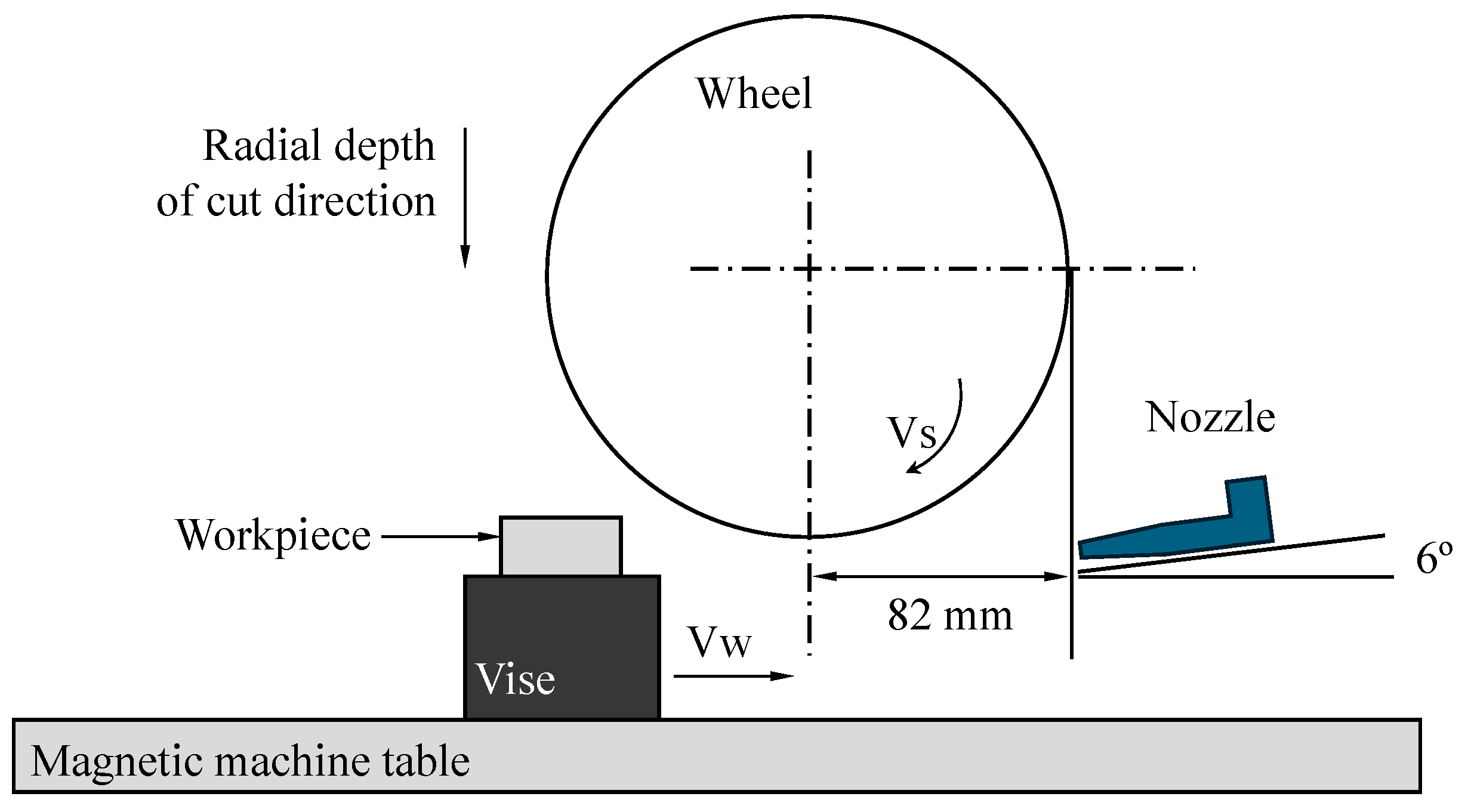

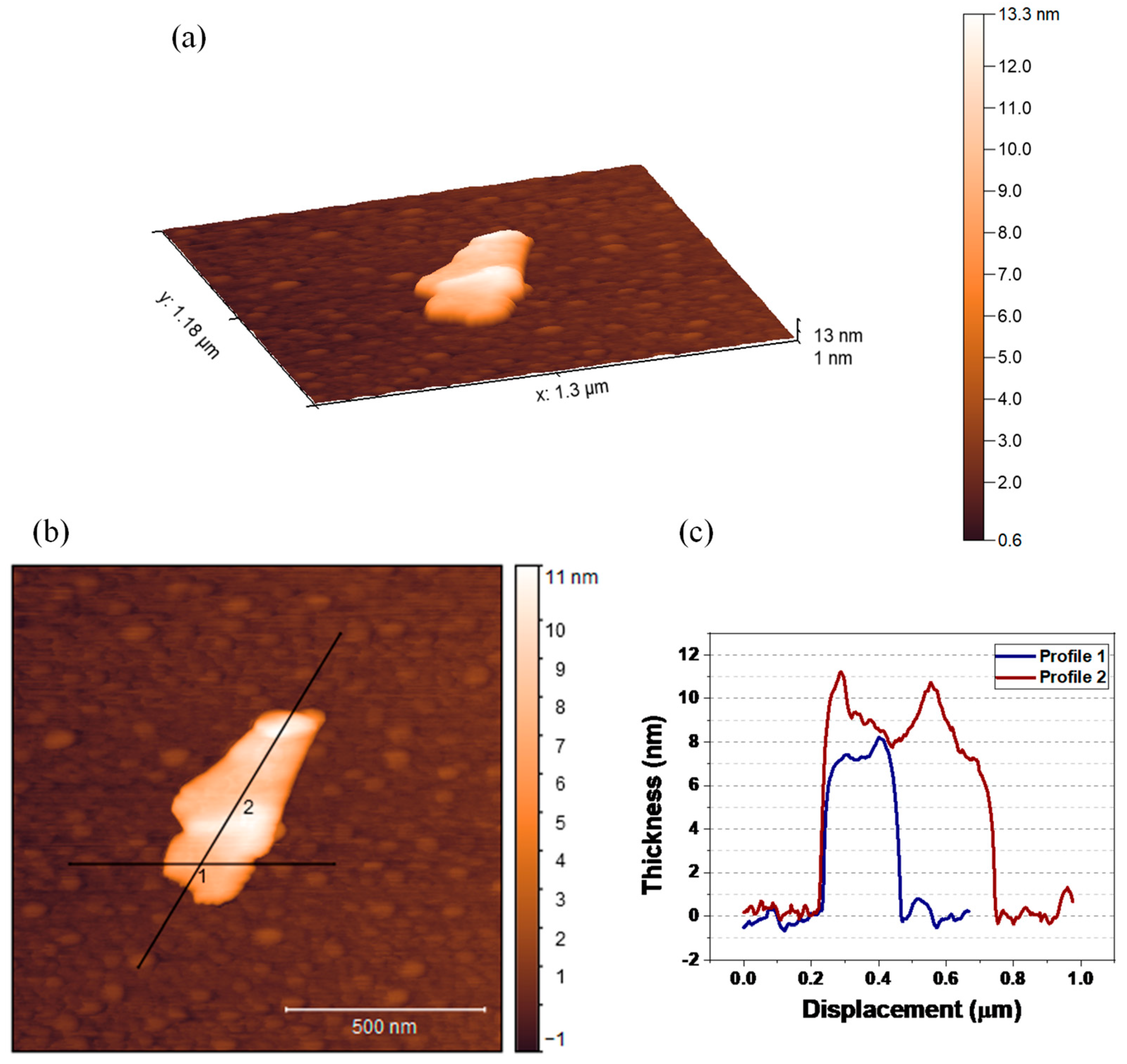
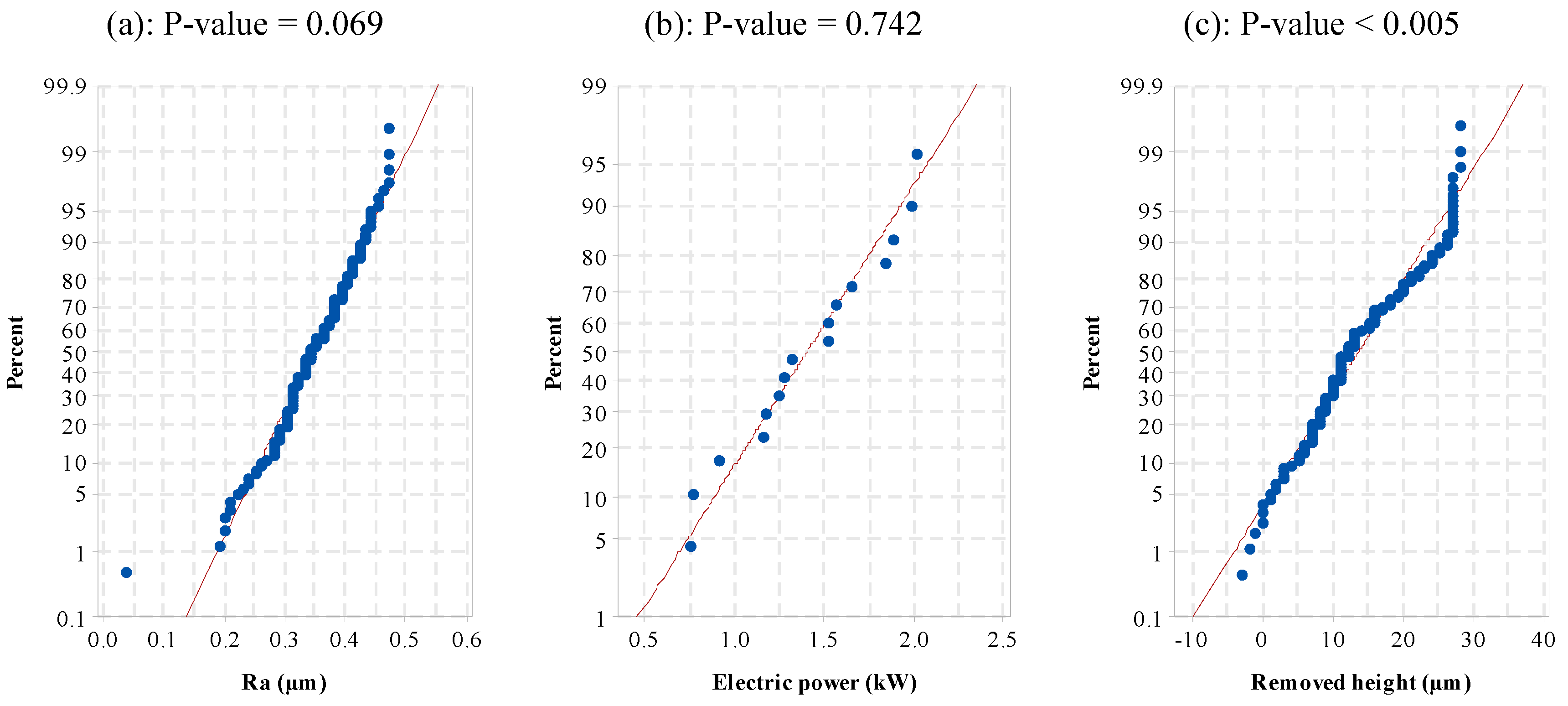
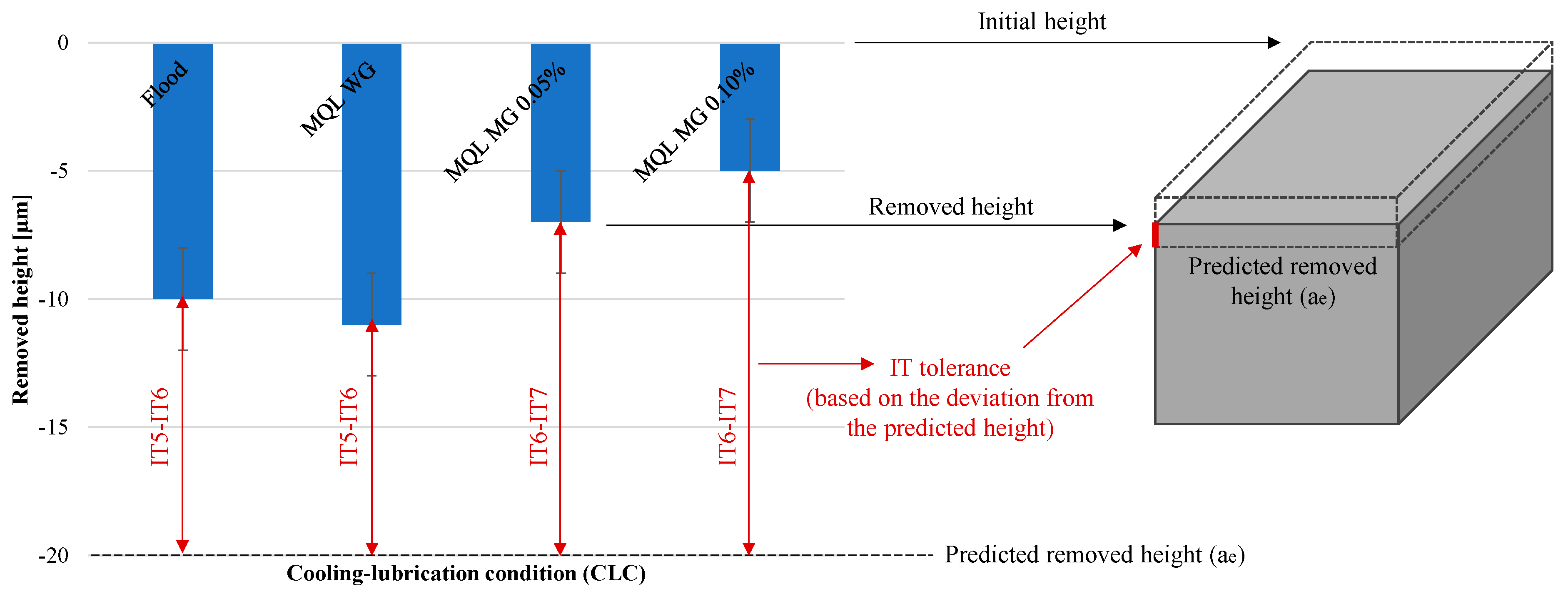
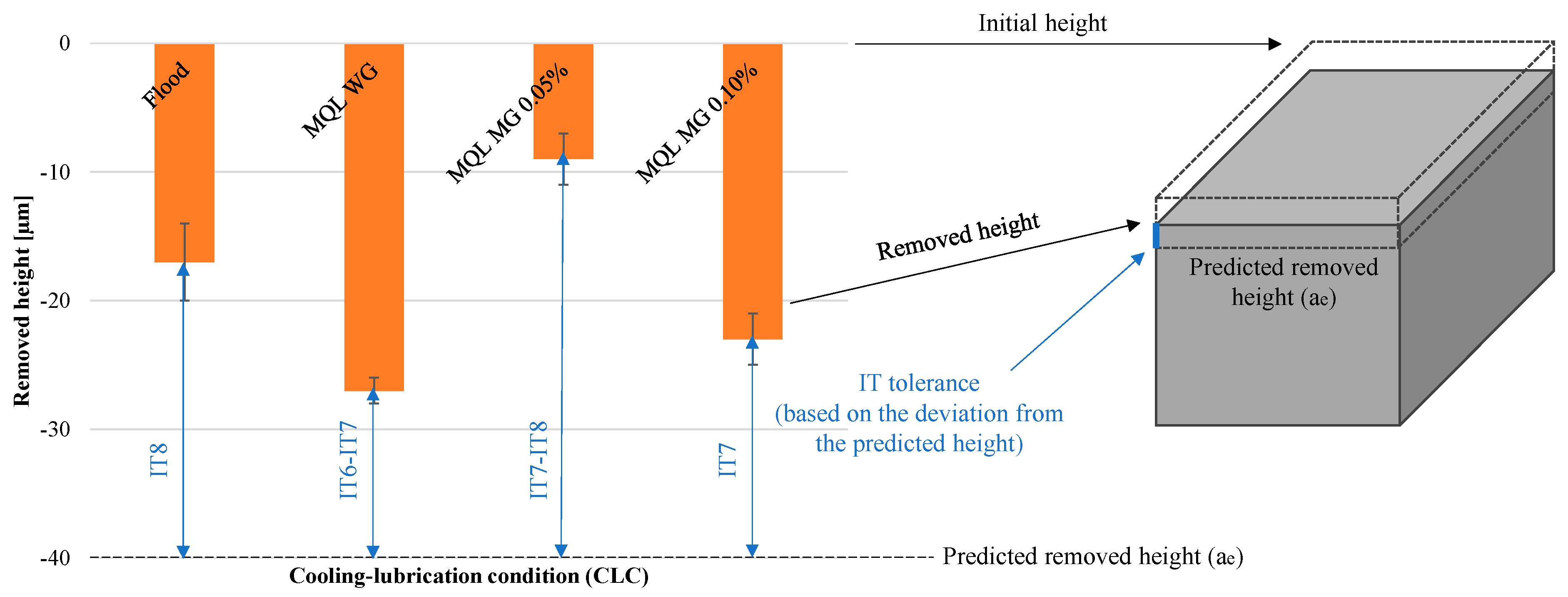
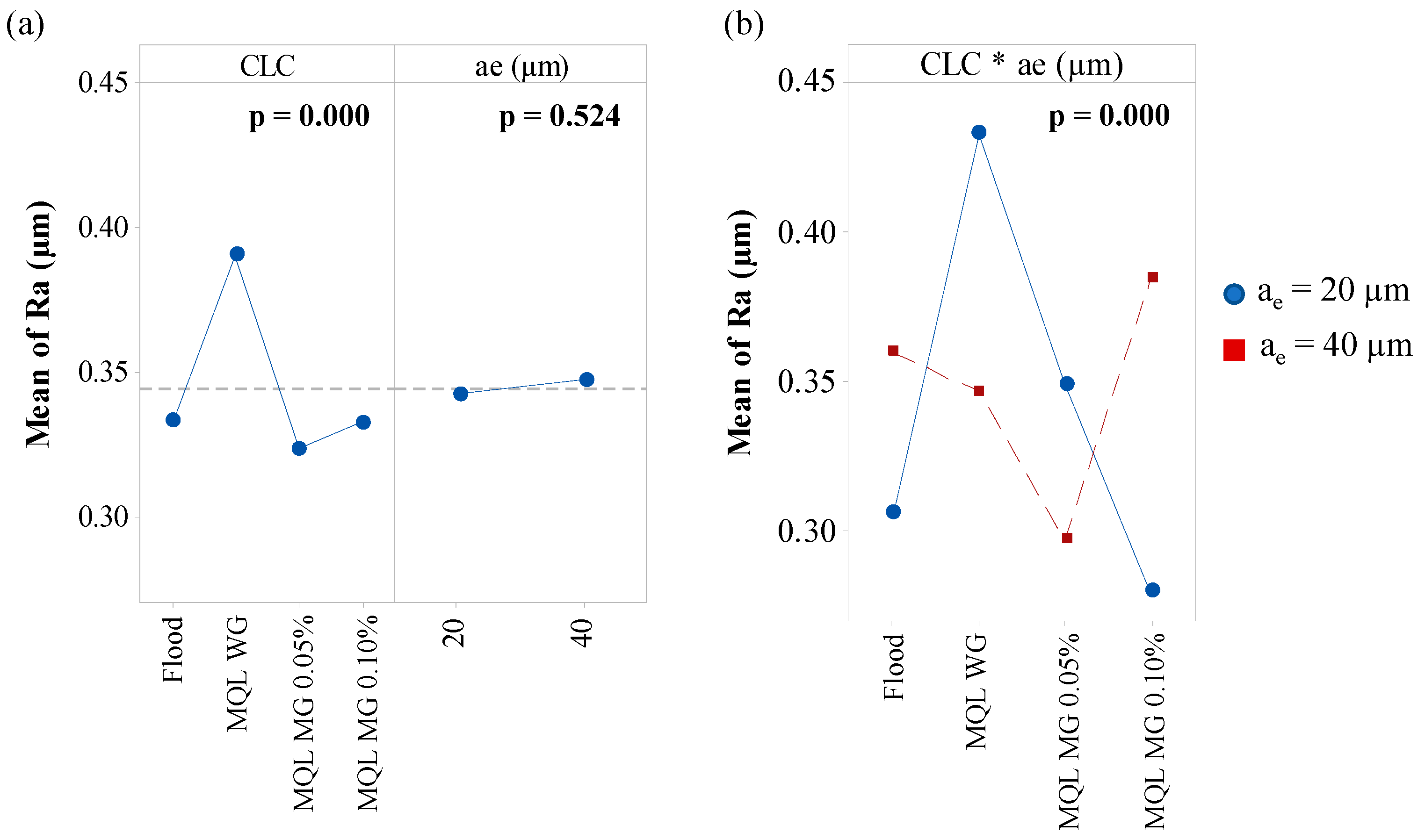

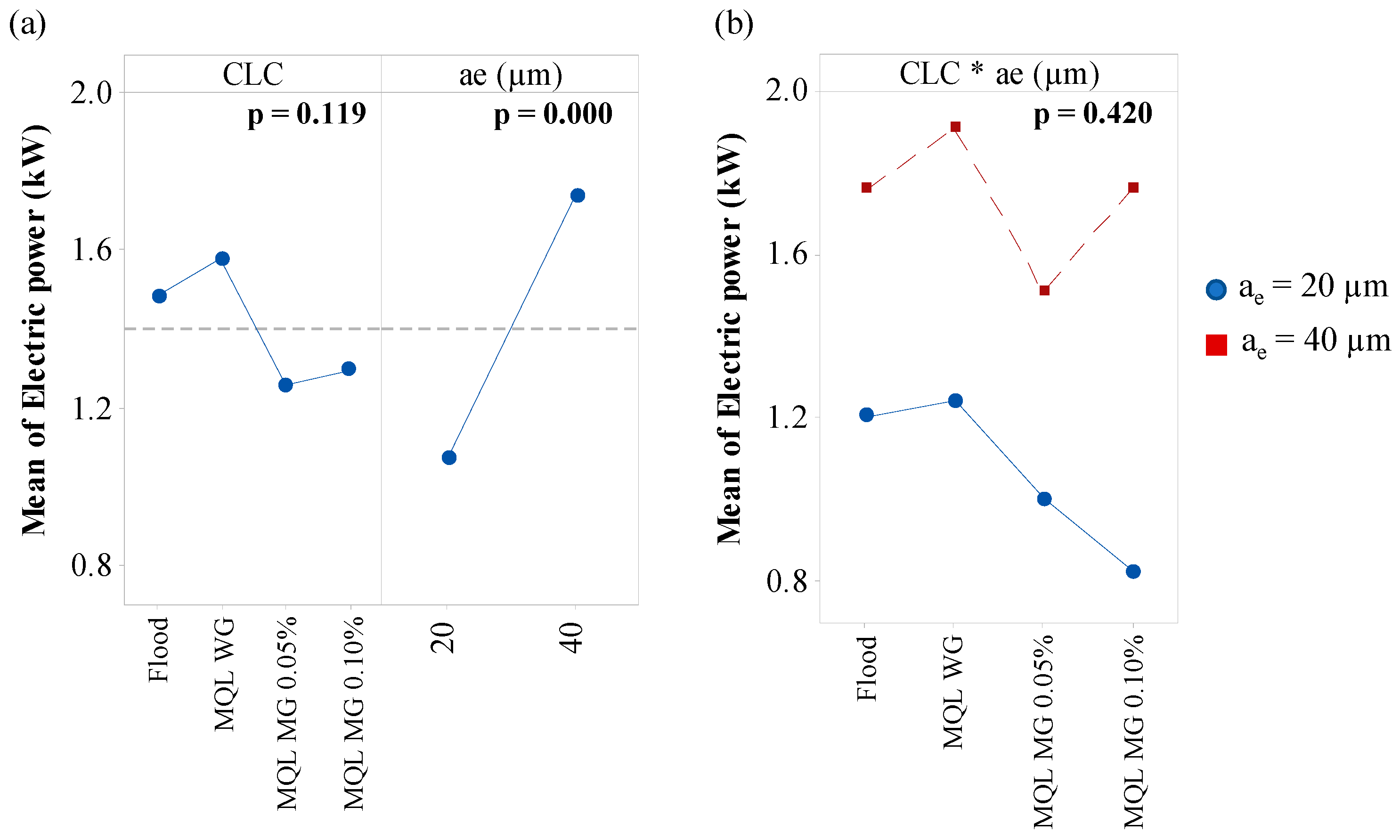
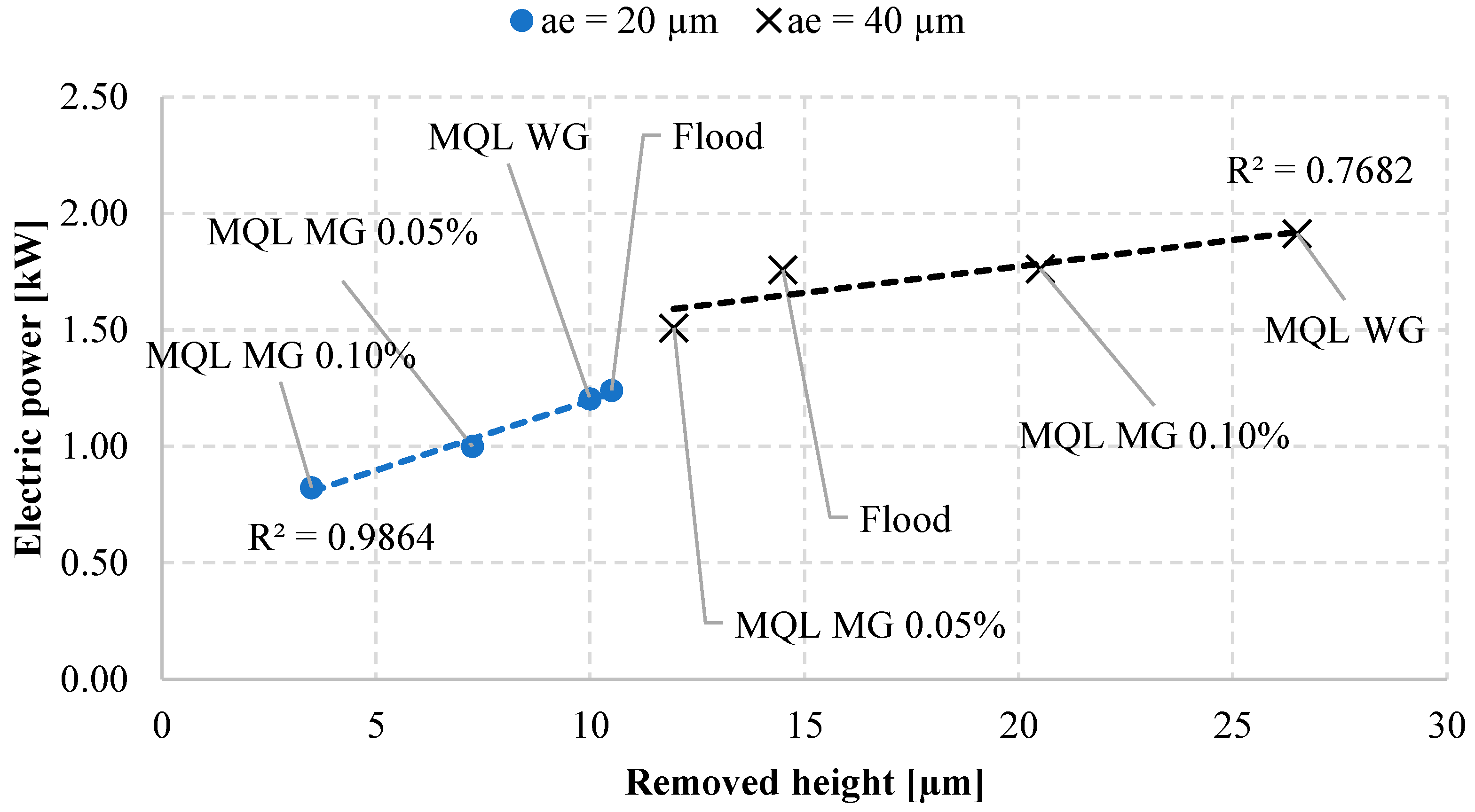
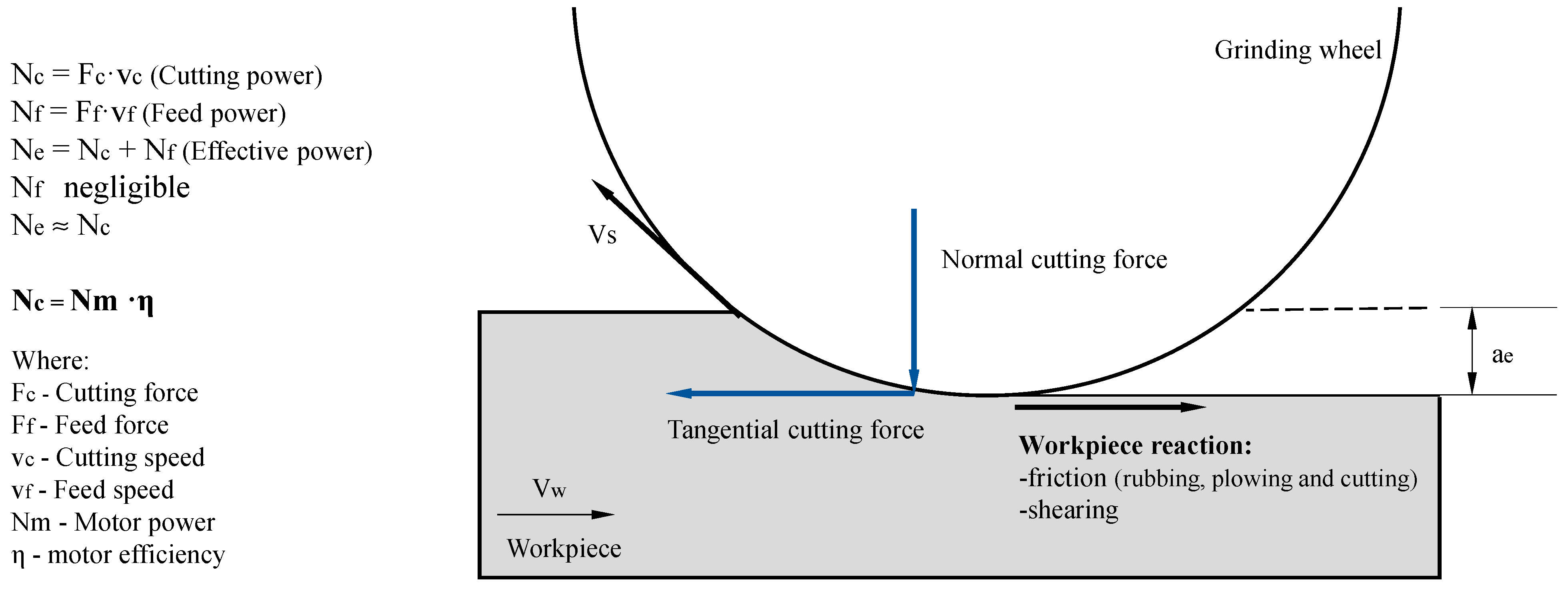
| Tensile Strength (σt—MPa) | Yield Strength (σy—MPa) | Young’s Modulus (E—GPa) | Hardness (HRC) | Density at Room Temperature (ρ—g/cm3) | Melting Range (°C) | Thermal Conductivity (λ—W/mK) |
|---|---|---|---|---|---|---|
| 1275 | 1034 | 200 | 40 | 8.22 | 1260–1336 | 11.4 |
| Element | C | Al | Ti | Cr | Fe | Ni | Nb | Mo |
|---|---|---|---|---|---|---|---|---|
| Percentage | 0.04 | 0.50 | 0.90 | 19.00 | 18.50 | 50.66 | 5.10 | 5.30 |
| Parameter | Cutting Speed (vs) | Workspeed (vw) | Radial Depth of Cut (ae) |
|---|---|---|---|
| Value | 38 m/s | 10 m/min | 20 µm; 40 µm |
| Dynamic Viscosity (m·Pa·s) | Thermal Conductivity (W·m−1K−1) × 10−001 | |||
|---|---|---|---|---|
| At 25 °C | At 50 °C | At 25 °C | At 50 °C | |
| Flood (oil + water) | 1.38 ± 0.01 | 0.86 ± 0.00 | 5.41 ± 0.08 | 5.00 ± 0.22 |
| MQL WG | 145.2 ± 0.41 | 44.82 ± 0.03 | 2.65 ± 0.04 | 2.64 ± 0.05 |
| MQL MG 0.05% | 157.18 ± 2.05 | 48.53 ± 0.54 | 2.83 ± 0.13 | 2.85 ± 0.21 |
| MQL MG 0.10% | 159.42 ± 0.74 | 48.97 ± 0.08 | 2.81 ± 0.31 | 1.65 ± 0.21 |
| Quantity | Estimation | P. D | T. A | D. F | C. S | Standard Uncertainty |
|---|---|---|---|---|---|---|
| t | A | n − 1 | 1 | |||
| ∆Rm | Rm | R | B | ∞ | 1 | |
| ΔCm | 0.0015 mm | t | B | ∞ | 1 |
| Test | Cooling-Lubrication Condition (CLC) | Radial Depth of Cut (ae) [µm] |
|---|---|---|
| 1 | Flood | 20 |
| 2 | 40 | |
| 3 | MQL WG (only oil) | 20 |
| 4 | 40 | |
| 5 | MQL MG 0.05 wt. % | 20 |
| 6 | 40 | |
| 7 | MQL MG 0.10 wt. % | 20 |
| 8 | 40 |
| Nominal Dimension (mm) | International Tolerance (IT) Grade | |||||||||
|---|---|---|---|---|---|---|---|---|---|---|
| IT1 | IT2 | IT3 | IT4 | IT5 | IT6 | IT7 | IT8 | IT9 | ||
| Above | Up to (Including) | Tolerance (µm) | ||||||||
| 6 | 10 | 1.0 | 1.5 | 2.5 | 4.0 | 6.0 | 9.0 | 15.0 | 22.0 | 36.0 |
| 10 | 18 | 1.2 | 2.0 | 3.0 | 5.0 | 8.0 | 11.0 | 18.0 | 27.0 | 43.0 |
| 18 | 30 | 1.5 | 2.5 | 4.0 | 6.0 | 9.0 | 13.0 | 21.0 | 33.0 | 52.0 |
| 30 | 50 | 1.5 | 2.5 | 4.0 | 7.0 | 11.0 | 16.0 | 25.0 | 39.0 | 62.0 |
| Flood | MQL WG | MQL MG 0.05% | MQL MG 0.10% | ||
|---|---|---|---|---|---|
| Removed height (mean value ± expanded uncertainty) [µm] | 10 ± 2 | 11 ± 2 | 7 ± 2 | 5 ± 2 | |
| Difference between removed height and set radial depth of cut (20 µm) | Highest deviation [µm] | 12 | 11 | 15 | 17 |
| Lowest deviation [µm] | 8 | 7 | 11 | 13 | |
| International tolerance grade for nominal dimension up to 30 mm | IT5–IT6 | IT5–IT6 | IT6–IT7 | IT6–IT7 | |
| Flood | MQL WG | MQL MG 0.05% | MQL MG 0.10% | ||
|---|---|---|---|---|---|
| Removed height (mean value ± expanded uncertainty) [µm] | 17 ± 3 | 27 ± 1 | 9± 2 | 23 ± 2 | |
| Difference between removed height and set radial depth of cut (40 µm) | Highest deviation [µm] | 26 | 14 | 29 | 15 |
| Lowest deviation [µm] | 20 | 12 | 33 | 19 | |
| International tolerance grade for nominal dimension up to 30 mm | IT8 | IT6–IT7 | IT7–IT8 | IT7 | |
Disclaimer/Publisher’s Note: The statements, opinions and data contained in all publications are solely those of the individual author(s) and contributor(s) and not of MDPI and/or the editor(s). MDPI and/or the editor(s) disclaim responsibility for any injury to people or property resulting from any ideas, methods, instructions or products referred to in the content. |
© 2025 by the authors. Licensee MDPI, Basel, Switzerland. This article is an open access article distributed under the terms and conditions of the Creative Commons Attribution (CC BY) license (https://creativecommons.org/licenses/by/4.0/).
Share and Cite
de Oliveira, D.; de Paiva, R.L.; Pereira, M.F.; Arencibia, R.V.; Gelamo, R.V.; da Silva, R.B. Dimensional and Surface Quality Evaluation of Inconel 718 Alloy After Grinding with Environmentally Friendly Cooling-Lubrication Technique and Graphene Enriched Cutting Fluid. Appl. Mech. 2025, 6, 50. https://doi.org/10.3390/applmech6030050
de Oliveira D, de Paiva RL, Pereira MF, Arencibia RV, Gelamo RV, da Silva RB. Dimensional and Surface Quality Evaluation of Inconel 718 Alloy After Grinding with Environmentally Friendly Cooling-Lubrication Technique and Graphene Enriched Cutting Fluid. Applied Mechanics. 2025; 6(3):50. https://doi.org/10.3390/applmech6030050
Chicago/Turabian Stylede Oliveira, Déborah, Raphael Lima de Paiva, Mayara Fernanda Pereira, Rosenda Valdés Arencibia, Rogerio Valentim Gelamo, and Rosemar Batista da Silva. 2025. "Dimensional and Surface Quality Evaluation of Inconel 718 Alloy After Grinding with Environmentally Friendly Cooling-Lubrication Technique and Graphene Enriched Cutting Fluid" Applied Mechanics 6, no. 3: 50. https://doi.org/10.3390/applmech6030050
APA Stylede Oliveira, D., de Paiva, R. L., Pereira, M. F., Arencibia, R. V., Gelamo, R. V., & da Silva, R. B. (2025). Dimensional and Surface Quality Evaluation of Inconel 718 Alloy After Grinding with Environmentally Friendly Cooling-Lubrication Technique and Graphene Enriched Cutting Fluid. Applied Mechanics, 6(3), 50. https://doi.org/10.3390/applmech6030050






